The Camino de Santiago is a large network of Pilgrim routes that stretch across Europe and all converge in Santiago de Compostela in north-west Spain.
Although traditionally used by pilgrims, you don’t necessarily have to be a pilgrim to walk the Camino de Santiago. This is one of the best thru hikes in the world and many walkers come from all over to experience the trail.
Here's a detailed guide to the 5 best Camino de Santiago routes.
Camino Quick Facts
- Camino de Santiago means way of Saint James.
- You need to walk at least 100km into Santiago in order to receive your Compostela Certificate.
- Over 200,000 pilgrims arrive in Santiago each year to receive their certificate.
- The Camino Primitivo is the oldest route of the Camino de Santiago.
- If you are walking as a pilgrim you will need a pilgrim passport which needs to be stamped at least once a day, this passport can also get you a free stay in albergues along the route.
Camino de Santiago
The Camino de Santiago has been declared a UNESCO World Heritage Site and is an incredible experience whether you are participating for religious reasons, fitness reasons or just if you are seeking an adventure.
Topography
The Camino de Santiago has a vastly varied topography due to the routes extending across multiple countries in Europe.
Each route has its own unique features. The Camino Francés is characterized by woodland paths, hills, mountains, villages and towns. Whereas, the Camino de Norte is characterized by Coastline, grassy fields, marshland and beaches. Each route is beautifully unique each with its own topography.
The Camino Primitivo has farmland, forests, mountains and villages. The Via de Plata varies as the route progresses as it is such a long walk. It can be dry and rocky at some points and lush and green at others.
Finally, the Camino Portugués consists of river valleys, steeper slopes and rural villages.
Wildlife and Plants
As mentioned with the topography of the Camino de Santiago, the topography and landscapes are extremely varied due to the routes existing in such a wide range of areas.
This means that the fauna and flora of the Camino de Santiago is also greatly varied.
There are a wide range of flowers, butterflies and birds along the routes and you are guaranteed to see more than a few farm animals on your walk as well as some wild animals, such as a wild fox or some smaller creatures, like tadpoles in the streams or caterpillars along the path.
There are beautiful plant species throughout and your senses will never be bored.
Hiking
When walking the Camino de Santiago, your choice of routes is seemingly endless as you can choose to complete entire routes or choose short portions and some of the routes converge with one another closer to the destination.
Although traditionally a pilgrimage you do not necessarily have to be a pilgrim to take part and enjoy the walk.
Pilgrims will however, be required to purchase a Camino passport if they are seeking to get their Compostela certificate.
Pilgrims need to walk at least 100km in order to obtain this certificate and they will also be required to get their Camino passport stamped at least once a day.
You may also like: What is the Camino de Santiago
Top 5 Camino De Santiago Trails
1. Camino Francés Trail
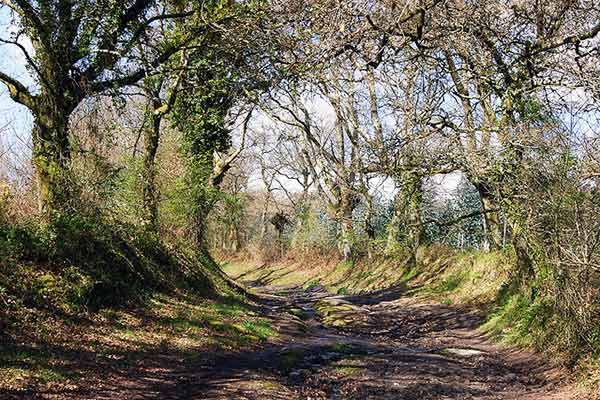
Photo by Sergey Andreevich
- Area: Begins in St Jean Pied-du-Port in France but is mostly in Spain
- Difficulty: Medium.
- Distance: 485miles (780km)
- Highest Point: 4,527ft (1,380m)
- Days/Hours: up to 35 nights
- Best Time to Hike: April – October
Route Description
This is the most popular route of the Camino de Santiago. It officially begins in the very important pilgrim town of St Jean Pied-du-Port in the French Pyrenees, this is the point where French pilgrims would traditionally begin their journey.
This is a remarkable and spectacular route, traversing through mountains and flat terrain and you will experience some of the most beautiful parts of Spain. It is a unique cultural and social experience.
This is an enjoyable walk with varied scenery and good infrastructure. This route is highly social, so if you are seeking a quieter experience this may not be the ideal route for you.
This is a well-trodden route with many hotels, cafés and restaurants along the way.
The last 111km of this route, starting in Sarria, is very popular as it perfectly captures the essence of the Camino de Santiago. 100km is the shortest distance you can walk and still receive your pilgrim certificate.
Looking for a reliable agency to help plan your walk? I recommend checking out Pilgrim.
Accommodation
- Albergues (hostels), you will need to be a pilgrim with a Camino passport to stay here. They cannot be booked in advance.
- Guesthouses.
- Hotels.
Camino Francés Trail Top Tips
- Wear good shoes.
- Pack light.
- Take photos using a high-quality camera.
- Be social.
- Summer is extremely busy, so it may be more ideal to visit in Autumn if you are seeking a quieter and less crowded experience.
2. Camino De Norte Trail
- Area: Spain
- Difficulty: Medium
- Distance: 510miles (872km)
- Days/Hours: 35 days
- Best Time to Go: May – October
Route Description
This route starts in Irún on the border with France and travels west through Bilbao, Santander and Oveido hugging the northern coast of Spain.
You will experience the magnificent Spanish coastline and joins the Camino Primivito for the final leg of the walk.
The route does include some hilly parts and the weather is not as warm as some of the more inland routes. The distance between towns is reasonable so you will never be too far away from refreshments and comfort.
This route is very scenic with lush green hills and mountains as well as stunning unspoilt beaches where you can take a dip if you choose to visit during the hot summer months.
Experience the narrow footpaths, panoramic estuaries, inland meadows and mountain backdrops.
You can expect to have a less crowded and more solitary and authentic experience along this route.
If you are a foodie, this route is definitely a must do as it passes through culinary cities that boast Michelin star restaurants.
Accommodation
- Albergues (hostels), you will need to be a pilgrim with a Camino passport to stay here. They cannot be booked in advance.
- Guesthouses.
- Hotels.
Camino de Norte Trail Tips
- Sparse accommodation, make sure you book ahead of time.
- It can be rainy and cold in the months outside of summer, so if you plan to visit during non-summer months, be prepared for rain.
3. Camino Portugués Trail
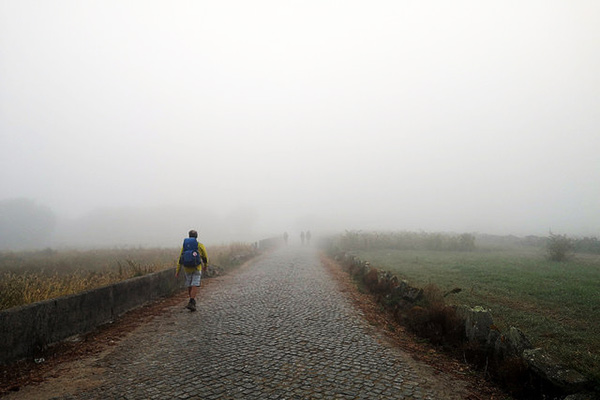
Photo by Ramon Bacas
- Area: Portugal
- Difficulty: Medium
- Distance: 380miles (600km)
- Days/Hours: Up to 29 nights
- Best Time to Go: April – October
Route Description
This route starts in Lisbon and goes north through Portugal and is the second most popular route behind the Camino Francés.
The route is relatively flat without too many hills and has reasonable infrastructure, however, most of the route goes alongside motorways.
The route takes you through stunning coastlines and sandy beaches. It is a great option if you are looking to get away from crowds but still have access to amenities.
This is a less, travelled more rural experience.
Accommodation
- Albergues (hostels), you will need to be a pilgrim with a Camino passport to stay here. They cannot be booked in advance.
- Guesthouses.
- Hotels.
Camino Portugués Tips
- The first few days involves a lot of cobblestone which can be hard on your feet, so take it slow.
- Keep in mind the 1-hour time difference as you pass from Portugal into Spain.
- There are fewer shops and restaurants along this route so make sure to plan ahead so you’re not left hungry.
- Avoid the months of June and July as the route gets busy and it is very hot.
4. Via del Plata Trail
- Area: Spain
- Difficulty: Medium
- Distance: 620miles (1000km)
- Days/Hours: Up to 48 nights
- Best Time to Go: Spring/Fall
Route Description
This is the longest route by far and covers almost the whole of Spain’s south-north length. The route begins in Seville and mostly follows an old Roman road, so this route is great if you are interested in Roman history.
The route is well-marked and is mostly paths and paved rock, it is very possible to do this route without a guide. It is easier than some of the other routes in terms of terrain, but some days can be very long with few facilities available.
The terrain is undulating and not very difficult with varied scenery. The route is quiet and easier than the other routes.
Accommodation
- Albergues (hostels), you will need to be a pilgrim with a Camino passport to stay here. They cannot be booked in advance.
- Guesthouses.
- Hotels.
Via del Plata Trail Tips
- Bring warm clothes as even in summer it can get cold at night.
- Try the food.
- If traveling alone, make sure you do your homework.
- Start your walk at 5am at least.
- Make sure to wear your hiking boots in beforehand.
- Don’t forget your Camino passport.
5. Camino Primitivo Trail
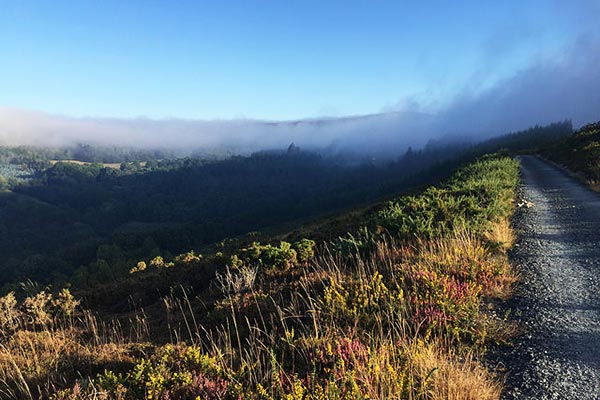
Photo by Damir Ritosa
- Area: Spain
- Difficulty: Challenging
- Distance: 180miles (311km)
- Days/Hours: Up to 15 nights
- Best Time to Go: April – November
Route Description
The Camino Primitivo, also known as the “Original Route,” is the most direct route from Oviedo to Santiago. This route re-joins the Camino Francés about 40-miles (64km).
The route is well-marked and begins in hilly farmland before crossing the Cantabrian Mountains. The route becomes challenging as it crosses through wild, wooded and sparsely populated sections with long ascents and descents.
But the route does become easier, so it won’t be challenging throughout your entire walk.
This route is challenging as it involves a lot of hill climbing and erratic weather. The first half can be particularly challenging, but the gorgeous views are definitely worth it.
Accommodation
- Albergues (hostels), you will need to be a pilgrim with a Camino passport to stay here. They cannot be booked in advance.
- Guesthouses.
- Hotels.
Camino Primitivo Trail Tips
- Roads can get quite muddy due to frequent rainfall. Make sure you pack accordingly to deal with the rain.
- You can make use of a backpack shuttle to transport your belongings to make your walk easier.
- The tap water is potable, so you won’t have to buy bottled water.
Useful Camino Information
Recommended Guidebook
This guidebook by John Brierley includes route descriptions and planners, maps, information about accommodation as well as facts about the Camino de Santiago.
It is the perfect companion on your journey, whether you are a pilgrim or not.
Travel Insurance
Although the odds of any major medical emergencies along the Camino are slim, it is always recommended to get travel insurance to avoid having to pay a great deal if something bad were to happen.
If you are from Europe, your European Health Insurance card will only cover the basics and it has been said that it may even be rejected in Spanish hospitals.
Therefore, purchase travel insurance before you depart to be safe.
This article on travel and hiking insurance proves great information on what type of insurance you need.
Camino De Santiago FAQ
What is the average distance covered per day on the Camino de Santiago?
10-15 miles (20-25km). You should try accomplishing 5km per hour.
How long does it take to walk the Camino de Santiago?
You're generally walking between 10 and 15 miles per day (20-25 km) so it would take between 30 and 35 days to complete the Camino de Santiago. It also varies greatly depending on the route that you take.
What is the longest Camino de Santiago route?
There is a wide range of distances among the Camino de Santiago routes. They range all the way from 56 miles / 90km (The Finisterre-muxia Way) to 596 miles / 960 km (the Via de la Plata Route). The longer routes have both walking and biking stages.
What is the recommended backpack weight for the Camino?
It is suggested that your backpack weight when fully loaded is around 10-12% of your bodyweight.
Do I have to carry my own bag on the Camino de Santiago?
Most people do, but there are services available to transport your bag at a small cost.
Do I need to speak Spanish to walk the Camino?
Not necessarily, but it is recommended that you learn a few basic phrases.
Do I have to be religious to walk the Camino de Santiago?
Although it is considered a religious journey, you do not have to be religious to participate.
Browse more hikes in Europe
See our top European hikes picks, or check out these popular hikes.
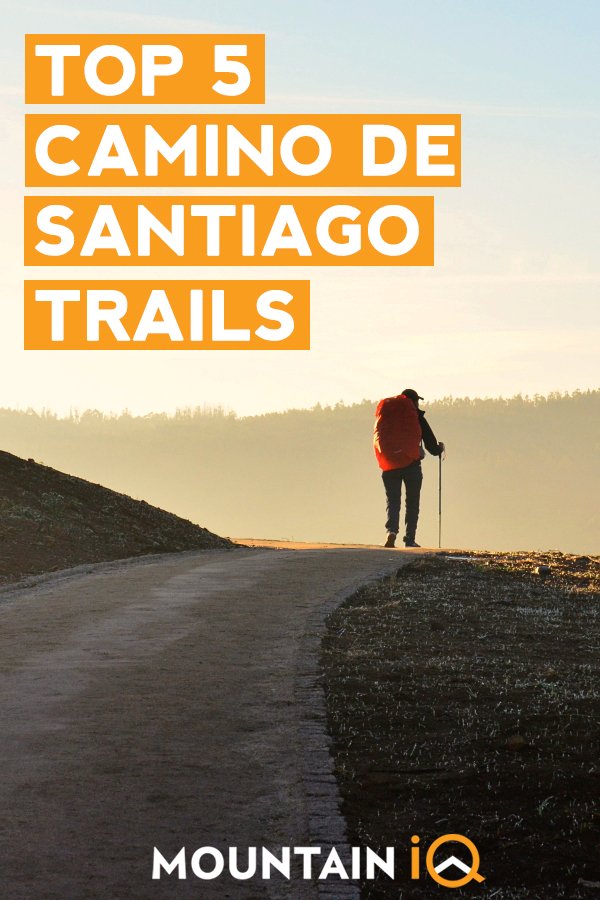

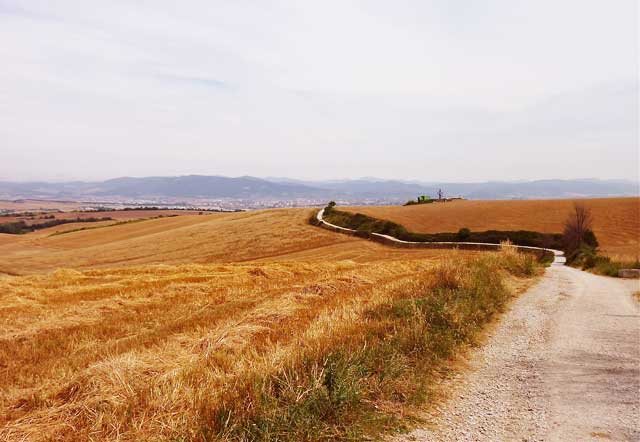

Good watch